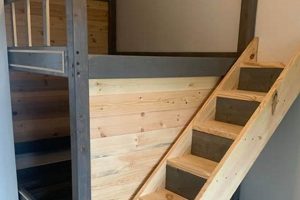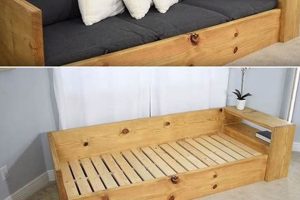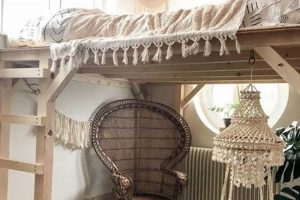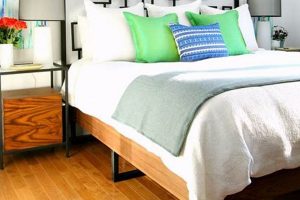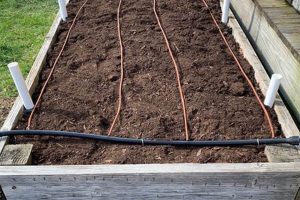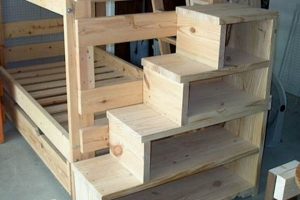Constructing a planting structure from zinc-coated iron or steel, elevated above ground level, designed for home assembly, represents a specific approach to gardening. This method combines the durability of a particular metal treatment with the advantages of elevated soil containment and user customization through a do-it-yourself approach. For instance, a homeowner might choose this method to create a contained vegetable plot in an area with poor native soil, building the structure themselves to match specific size requirements.
The benefits of this type of construction extend beyond simple containment. Elevated structures mitigate soil compaction, improve drainage, and can provide a barrier against certain pests. The zinc coating offers corrosion resistance, prolonging the lifespan of the structure. The do-it-yourself aspect allows for significant cost savings and customization, enabling gardeners to tailor their planting area to their individual needs and preferences. This technique addresses concerns about soil quality, accessibility, and overall garden design, finding roots in both practical solutions and aesthetic gardening trends.
The subsequent sections will delve into specific construction techniques, material considerations, safety precautions, and optimal planting practices for utilizing this type of garden structure, providing detailed information for successful implementation and maintenance.
Essential Guidance for Zinc-Coated Iron/Steel Elevated Planting Structure Self-Assembly
The following provides actionable insights to optimize the construction and utilization of elevated gardening structures made from coated steel or iron, assembled by the user. Attention to these details can improve structural integrity, longevity, and horticultural productivity.
Tip 1: Prioritize Material Gauge: When selecting steel panels, a thicker gauge is preferable for enhanced structural stability and resistance to bowing, particularly in larger beds. Consider at least 18-gauge steel for beds exceeding 4 feet in length or width.
Tip 2: Implement Soil Stabilization Techniques: To prevent outward pressure from the soil, reinforce the interior walls with bracing. Wooden supports or steel rods attached horizontally across the interior can significantly improve structural integrity, especially when using heavier soil mixtures.
Tip 3: Ensure Proper Drainage: While the raised nature inherently improves drainage, ensure the base permits water runoff. Avoid placing the structure directly on impervious surfaces without adequate drainage provisions. Consider adding a layer of gravel or landscape fabric to the bottom before adding soil.
Tip 4: Address Potential Sharp Edges: After assembly, thoroughly inspect all edges and corners for sharpness. Use edge protectors or file down any sharp points to prevent injury during gardening activities. Safety gloves are highly recommended during the assembly process.
Tip 5: Optimize Soil Composition: Tailor the soil mix to the intended plants. A blend of topsoil, compost, and other amendments ensures adequate nutrient availability and drainage. Conduct soil tests periodically to monitor pH levels and nutrient content.
Tip 6: Consider Geographic Location: Adapt the bed’s design to the local climate. In hotter regions, lighter-colored steel reflects sunlight, reducing soil temperature. In colder regions, darker colors can help retain heat.
Tip 7: Protect Against Corrosion: While the zinc coating provides protection, inspect the structure annually for any signs of rust or corrosion. Address any blemishes promptly with rust-inhibiting paint specifically designed for metal surfaces.
These considerations contribute to a more robust, effective, and safe elevated garden structure. Careful planning and diligent execution result in a long-lasting asset for gardening pursuits.
The subsequent article sections will explore planting strategies and maintenance practices to maximize the productivity of this type of gardening structure.
1. Durability
The lifespan and resistance to environmental factors are paramount considerations when evaluating galvanized steel for elevated planting structures assembled by the user. Durability directly impacts the long-term cost-effectiveness and practical usability of such garden beds.
- Zinc Coating Integrity
The galvanized layer serves as the primary defense against corrosion. Damage to this layer, through scratches or dents, exposes the underlying steel to moisture and oxygen, accelerating rust formation. Regular inspection and prompt repair of any breaches in the zinc coating are essential for maintaining the structural integrity of the bed.
- Steel Gauge and Thickness
The gauge, or thickness, of the steel used in construction directly correlates with its ability to withstand physical stress. Thicker steel offers greater resistance to bending, denting, and general wear and tear, particularly when filled with heavy soil and subjected to the pressures of root growth and soil settling. Lower gauge numbers indicate thicker steel and, consequently, improved durability.
- Joint and Fastener Strength
The method of joining steel panels, whether through welding, bolting, or screwing, influences the overall structural stability. Weak joints or inadequate fasteners can compromise the bed’s ability to withstand the lateral pressure exerted by the soil. Selecting high-quality fasteners and employing robust joining techniques are crucial for preventing structural failure.
- Environmental Factors and Climate
Exposure to harsh weather conditions, such as extreme temperatures, high humidity, or frequent rainfall, can accelerate corrosion, even with a protective zinc coating. Acidic soils or the application of certain fertilizers can also contribute to the degradation of the steel. Understanding local environmental factors and taking appropriate preventative measures, such as applying protective coatings or choosing corrosion-resistant fasteners, extends the structure’s lifespan.
These interconnected factors collectively determine the robustness of the elevated gardening structure. Careful attention to material selection, construction techniques, and environmental considerations allows for the creation of long-lasting and reliable planting areas constructed using this method.
2. Assembly
The construction process is intrinsically linked to the viability of a zinc-coated iron/steel elevated gardening structure produced through user self-assembly. The ease and accuracy of joining the constituent components directly affect the structural integrity and long-term performance of the planting bed. For instance, a poorly aligned joint between panels can create a point of weakness, leading to premature failure under the weight of the soil and plants. Conversely, a well-executed assembly using appropriate fasteners ensures uniform distribution of stress and maximizes the lifespan of the unit. The do-it-yourself nature of the project necessitates clear instructions, readily available tools, and manageable component weights to ensure successful construction by individuals with varying levels of experience.
Considerations during the assembly phase extend beyond the physical act of joining materials. Proper site preparation, including leveling the ground and ensuring adequate drainage, is crucial for preventing distortion of the structure over time. Furthermore, the order in which components are assembled can significantly impact the overall stability. For example, fully tightening all fasteners before ensuring square alignment can lead to racking and increased stress on individual joints. Therefore, a systematic approach, guided by comprehensive instructions and a thorough understanding of the underlying principles of structural support, is essential for a successful outcome. The practical implications of this understanding are evident in the numerous online resources and community forums dedicated to troubleshooting common assembly challenges and sharing best practices.
In summary, the process of assembly represents a critical juncture in the creation of a functional and durable elevated gardening structure. From the selection of appropriate fasteners to the implementation of proper alignment techniques, each step in the construction process contributes to the overall performance and longevity of the bed. Addressing potential challenges through careful planning, adherence to instructions, and a proactive approach to problem-solving minimizes the risk of structural failure and maximizes the return on investment for individuals undertaking this type of self-assembly project. The success of galvanized steel elevated structures directly correlates with the quality of assembly.
3. Drainage
Effective water management constitutes an integral component of any elevated planting structure, particularly those utilizing galvanized steel. The impermeable nature of steel, while providing structural integrity, necessitates deliberate drainage strategies. Insufficient drainage leads to waterlogged soil, creating anaerobic conditions detrimental to root health and potentially fostering root rot. Conversely, excessive drainage may result in nutrient depletion and necessitate more frequent irrigation. The design and construction of the bed, therefore, must incorporate measures to achieve optimal moisture balance within the soil profile.
Real-world examples illustrate the importance of this consideration. A bed constructed without drainage holes, placed directly on a concrete patio, invariably experiences water accumulation after rainfall. This saturated environment inhibits oxygen uptake by plant roots, leading to stunted growth or even plant death. Conversely, a bed constructed with excessively large drainage holes, filled with a coarse, fast-draining medium, may require daily watering, particularly in warm climates, depleting valuable resources. The selection of appropriate soil amendments, such as perlite or vermiculite, further influences drainage characteristics. Furthermore, the inclusion of a gravel layer at the base of the bed promotes water flow and prevents soil compaction around drainage openings.
The practical significance of understanding the interplay between material properties, soil composition, and drainage lies in its direct impact on plant health and the overall success of the gardening endeavor. By carefully considering drainage requirements during the design and construction phases, gardeners can create a self-regulating ecosystem within the bed, promoting vigorous plant growth and minimizing the need for intervention. Balancing water retention and drainage ensures plants receive adequate moisture and nutrients, resulting in higher yields and healthier foliage. Thus, drainage directly impacts the performance of the garden.
4. Materials
The selection of appropriate materials dictates the structural integrity, longevity, and overall safety of a self-assembled, zinc-coated iron/steel elevated planting structure. The core material, galvanized steel, provides the primary framework, while secondary components such as fasteners, edging, and soil amendments collectively contribute to the functionality and performance of the planting bed. A deficiency in any of these materials undermines the entire structure, potentially leading to premature failure or environmental contamination.
For instance, utilizing low-grade fasteners susceptible to corrosion jeopardizes the joints connecting the steel panels, increasing the risk of collapse under the weight of saturated soil. Similarly, neglecting to line the interior with a non-toxic barrier may result in the leaching of zinc or other heavy metals into the soil, contaminating the growing medium and posing a threat to plant health and human consumption. Conversely, selecting high-quality galvanized steel with a sufficient zinc coating thickness, coupled with corrosion-resistant fasteners and a food-grade liner, maximizes the lifespan of the bed and ensures a safe growing environment. The choice of soil amendments also influences drainage, aeration, and nutrient availability, directly impacting plant vigor and productivity. Soil compaction, resulting from inadequate drainage, can impede root development and nutrient uptake, even with high-quality galvanized steel. The materials work together; even a top-quality galvanized steel cannot compensate for poorly chosen or applied companion materials.
The practical significance of understanding material properties and their interdependencies lies in enabling informed decision-making during the construction phase. Prioritizing quality over cost in material selection translates to reduced maintenance, extended lifespan, and a healthier growing environment. By carefully evaluating the characteristics and compatibility of each component, individuals can create robust and sustainable elevated planting structures that effectively address specific gardening needs while mitigating potential risks.
5. Longevity
The achievable lifespan of a planting structure constructed from zinc-coated iron or steel, elevated above ground, and assembled by the user, is fundamentally intertwined with material selection, construction techniques, and ongoing maintenance practices. The inherent corrosion resistance of galvanized steel provides a baseline for extended use, but its actual duration hinges on minimizing factors that accelerate degradation. For instance, inadequate joint protection allows moisture to penetrate seams, initiating rust. Similarly, physical damage to the zinc coating compromises its protective barrier, expediting corrosion. Therefore, achieving maximum lifespan requires a multifaceted approach that anticipates and mitigates potential sources of failure.
Consider two contrasting scenarios: In the first, a bed is constructed from thin-gauge steel, assembled with inferior fasteners, and left exposed to harsh weather conditions without any protective measures. This bed will likely exhibit signs of rust and structural weakening within a few years, necessitating costly repairs or complete replacement. Conversely, a bed constructed from thicker-gauge steel, meticulously assembled with corrosion-resistant fasteners, lined with a protective barrier, and periodically inspected for signs of damage, can potentially last for decades. The initial investment in higher-quality materials and careful construction yields a significant return in terms of extended service life and reduced maintenance costs. The longevity of the garden is determined during the time it is constructed.
Ultimately, the relationship between longevity and this specific type of gardening structure centers on proactive management. Addressing potential vulnerabilities early in the design and construction phases, coupled with diligent maintenance practices, significantly extends the structure’s lifespan. This approach not only maximizes the value of the investment but also minimizes environmental impact by reducing the need for frequent replacements. The understanding of factors influencing the lifespan is vital to making informed decisions about materials and maintenance.
6. Ergonomics
Ergonomics, the science of designing and arranging items to maximize efficiency and safety, holds substantial relevance to the construction and utilization of galvanized steel elevated planting structures assembled through self-directed projects. The elevated nature of these structures inherently alters the physical demands placed upon the gardener, potentially reducing strain on the back, knees, and other joints. However, the degree to which this benefit is realized depends on the precise dimensions and configuration of the bed, as well as the individual gardener’s physical capabilities. A structure that is too low may still require excessive bending or kneeling, negating the ergonomic advantages. Conversely, a structure that is too high may necessitate reaching or stretching, leading to shoulder or arm fatigue. The interaction between these dimensions and human biomechanics is critical for realizing the full ergonomic potential. This consideration directly affects the health and well-being of individuals engaged in gardening activities.
Practical applications of ergonomic principles in these projects involve careful consideration of bed height, width, and accessibility. For example, individuals with mobility limitations may benefit from taller beds that eliminate the need to bend over completely. Similarly, narrower beds allow for easier access to plants without excessive reaching. The inclusion of features such as built-in seating or tool storage can further enhance usability and reduce physical strain. Furthermore, the choice of lightweight soil amendments and ergonomic gardening tools can minimize the physical effort required for planting, weeding, and harvesting. The design should adapt to the individual doing the gardening. The success of “galvanized steel raised garden bed diy” hinges on ergonomics.
In summary, integrating ergonomic principles into the design and construction of galvanized steel elevated planting structures enhances the gardening experience by reducing physical strain and promoting comfort. The selection of appropriate dimensions, the inclusion of user-friendly features, and the adoption of ergonomic gardening practices collectively contribute to a more sustainable and enjoyable gardening experience. Addressing ergonomic considerations early in the planning process leads to a more functional and beneficial gardening environment, particularly for individuals with physical limitations or those seeking to minimize strain during gardening activities.
Frequently Asked Questions
This section addresses common inquiries regarding the construction and utilization of elevated planting structures made from zinc-coated steel, assembled by the user. The information presented aims to provide clarity and guidance for successful implementation.
Question 1: Is galvanized steel safe for growing edible plants?
Generally, galvanized steel is considered safe for growing edible plants. The zinc coating acts as a barrier between the steel and the soil, preventing significant leaching of zinc into the growing medium. However, it is advisable to use a food-grade liner, particularly for acidic soils, which may accelerate zinc dissolution. Older galvanized steel may contain lead; avoid using it.
Question 2: What gauge of steel is recommended for building a raised garden bed?
A steel gauge of 18 or thicker is recommended for constructing a raised garden bed, especially for larger beds exceeding 4 feet in any dimension. Thicker steel provides greater structural stability and resistance to bowing under the weight of the soil. Lower gauge numbers indicate thicker steel.
Question 3: How should the soil be prepared for a galvanized steel raised garden bed?
The soil should be a well-draining mix of topsoil, compost, and other amendments appropriate for the plants being grown. A layer of gravel or landscape fabric at the bottom of the bed improves drainage and prevents soil loss. Periodic soil testing is recommended to monitor pH levels and nutrient content.
Question 4: How can rust formation be prevented on galvanized steel raised garden beds?
Rust formation can be minimized by maintaining the integrity of the zinc coating. Avoid scratching or damaging the steel. Any exposed areas should be treated with a rust-inhibiting paint specifically designed for metal surfaces. Proper drainage also reduces moisture exposure.
Question 5: What is the best method for joining steel panels when constructing a raised garden bed?
Steel panels can be joined using bolts, screws, or welding. Bolting or screwing is generally preferred for do-it-yourself projects. Use corrosion-resistant fasteners and ensure joints are tight and secure. Welding requires specialized equipment and expertise.
Question 6: Does a galvanized steel raised garden bed require any special maintenance?
Galvanized steel raised garden beds require minimal maintenance. Inspect the structure annually for signs of rust or damage. Clean the surface periodically to remove debris and prevent staining. Replenish soil as needed and amend the soil based on soil tests.
These answers provide a foundation for informed decision-making regarding construction and upkeep. Attention to these details contributes to successful and long-lasting gardening ventures.
The following section delves into advanced construction considerations, focusing on design modifications and enhancements.
Concluding Remarks
This exploration has detailed the multifaceted aspects of constructing elevated planting structures using zinc-coated iron or steel, assembled through do-it-yourself methodologies. From material selection and assembly techniques to drainage considerations, longevity factors, and ergonomic principles, a comprehensive understanding of these elements is paramount for successful implementation. The integration of quality materials, sound construction practices, and proactive maintenance protocols ensures a robust and sustainable gardening solution.
The construction of elevated planting structures using the described methods offers a tangible pathway to enhanced horticultural practices. By understanding how material, drainage, construction and ergonomics create an efficient long-lasting product, one can reap the rewards and benefits of a garden structure that will last. Prospective builders should carefully consider the outlined guidelines to maximize the utility and longevity of their planting structures.


